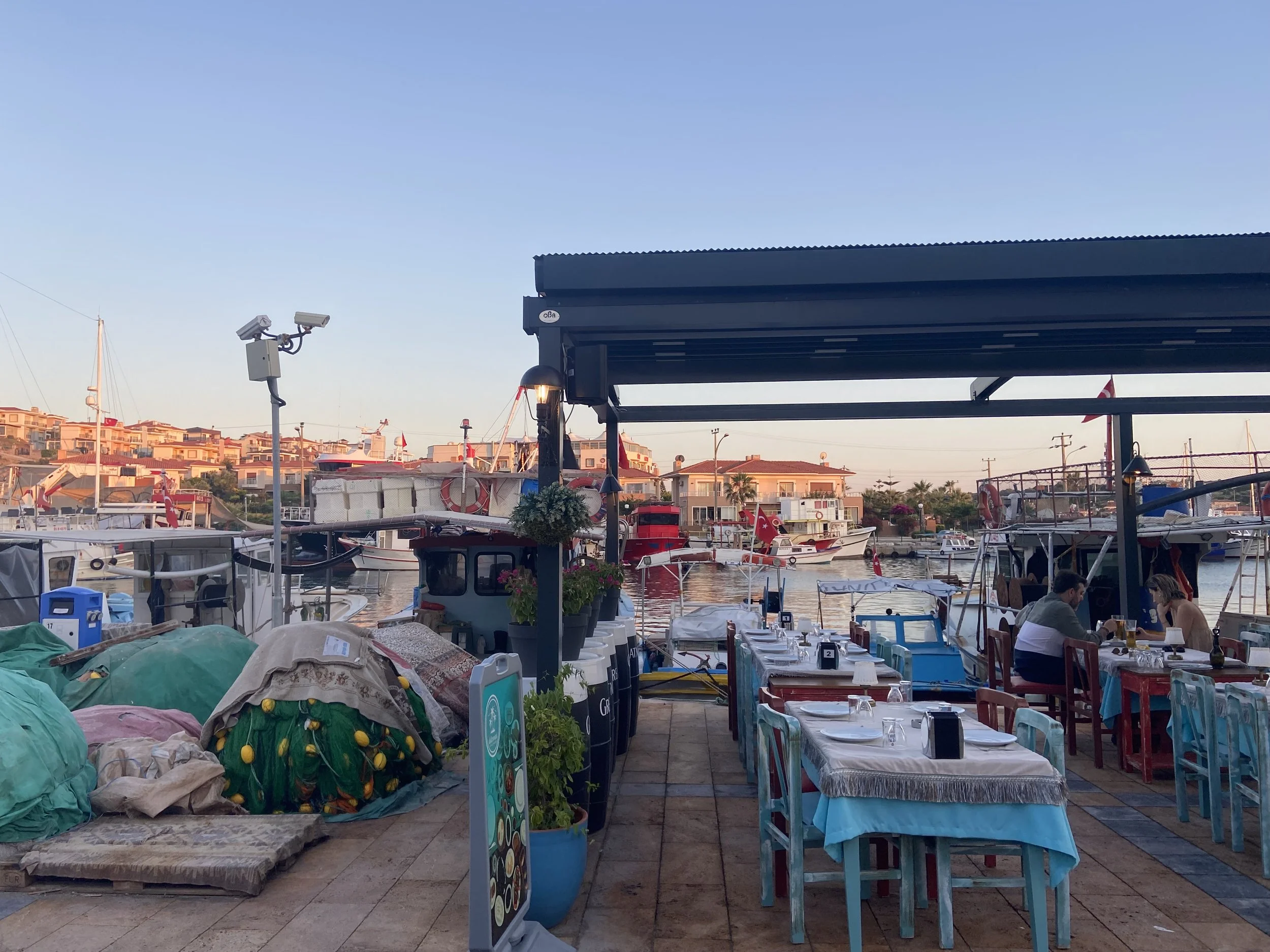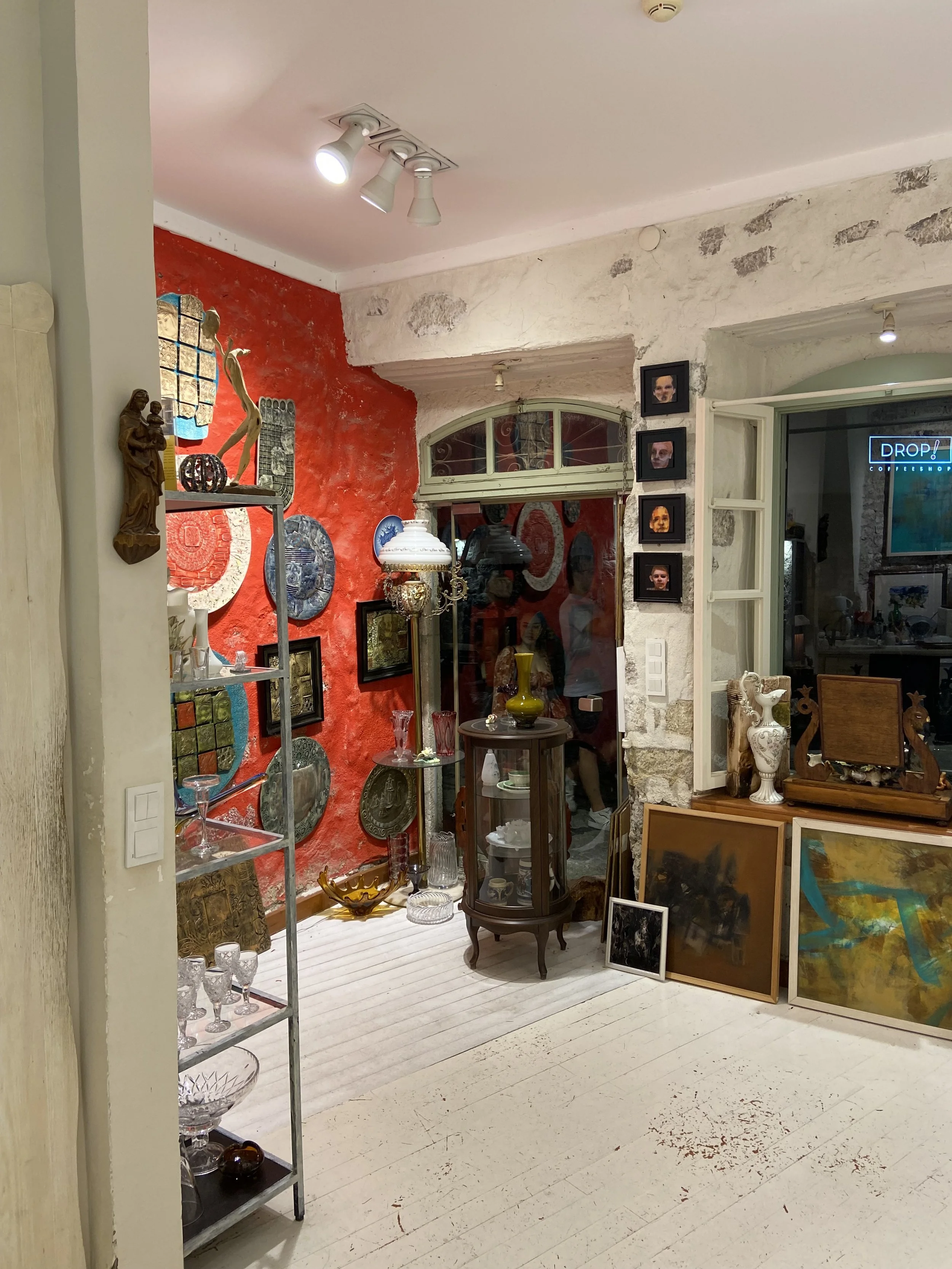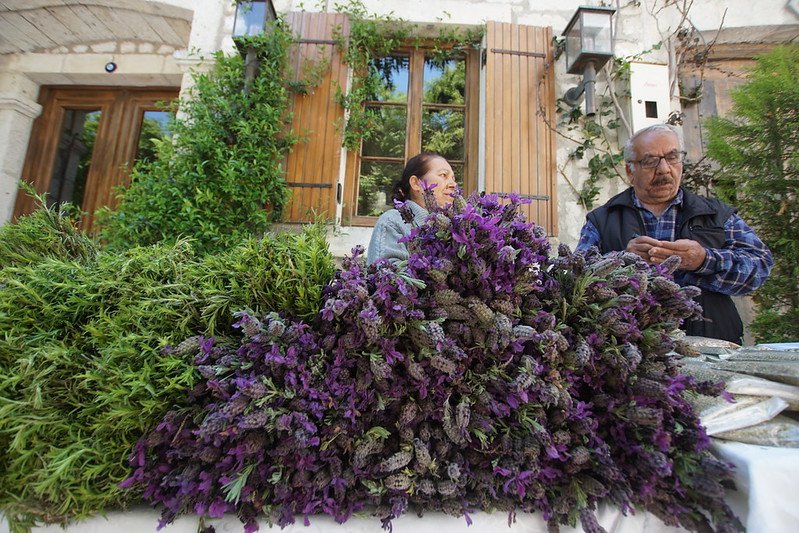Exploring the places where I feel most connected to my Turkish heritage.
Cesme. CharlesFred. CC BY-NC-SA 2.0.
The First Steps: Traveling to Turkey
An ocean view near my grandparent’s house in Cesme. Su Ertekin-Taner.
Today, my mom, younger sister, and I begin the first leg of our family’s annual trip to Turkey. Usually, we visit my Turkish parents’ childhood homes on these yearly trips, learning personal and national history that is too distant in the United States, where few close relatives live. I am a U.S. citizen with a Turkish identity. These trips help parse out parts of me, aid in my understanding of who I am — with, of course, a bit of leisure and excitement. Soon we will be partaking in this tradition. We will arrive at Cesme, where my mom’s side of the extended family waits for us. Cesme, one of the most popular vacation spots in Turkey, fills up this time of year. Located on the country’s western coast, this small town attracts many visitors from nearby Izmir, who eagerly travel an hour by car, and even some from Istanbul, who may not so eagerly await their six hour ride to the resort town.
Regardless, they all flock to Cesme. The town’s name means “fountain” in Turkish; accordingly, many come for the beaches and the water of the Aegean Sea — the fountain of the earth — but Cesme has much more to offer than that: resorts, day hikes, the Cesme castle, artisan shops, seafood restaurants, and orbiting small towns like Dalyan and Alacati.
Now, I’m getting eager and I know my extended family is too. A year has been too long for them. A year has been too long for me.
The ten hour flight doesn’t fly by. Instead, the minutes pass begrudgingly. I pass them thinking of the waves, the harbor, my grandparents’ Cesme house. Soon, but not soon enough, we arrive at a familiar small house pushed claustrophobically against its neighbors. Flowers and vines grow everywhere, and a bird or two coo. Across from my mom’s childhood home, the bright blue Aegean stretches out for miles. My eyes barely acclimate to this sort of paradise on Earth before I fall asleep.
Dalyan Harbor
Cesme. CharlesFred. CC BY-NC-SA 2.0.
A view of the Dalyan harbor. Su Ertekin-Taner.
A bite of lokma. Su Ertekin-Taner.
My mom takes me down to Dalyan via a cheap but reliable minibus. Dalyan is another small harbor town just an hour outside of the main Cesme gathering grounds, between the Fethiye and Marmaris districts. While our minibus trip takes thirty minutes, the town is an hour and a half drive from the Izmir airport.
Dalyan, though small and with a population of a little more than a couple thousand, offers many nautical traditions. The riverside dining experience is famed not only for its gastronomy (the fish), but also the riverside aspect; day-long boat tours float along the coast of the town, stopping in the odd Dalyan mud bath; and oh, the beaches. The finest salt water, found for example at Iztuzu Beach, cleanses and captivates swimmers and paddlers.
But now, it is night. We might engage in those activities later. For now, we’re walking through a quiet town. Although this town isn’t loud, its colors are: they shout their pride willingly. The green fishnets, the red-mauve roofs of houses, the turquoise pots of green leaves, the constant blue of the Aegean sea. There are too many hues to count, or rather identify.
We greedily walk near the harbor first, our eyes hungering for the myriad colors. Fish restaurants — typical of Dalyan — line the scenery, some more crowded than others, some more touristy than others. The diners have just started their mezzes, a kind of Turkish tapas, or they’re readily consuming their main course, of which sea bass is the most popular. A small band plays outside one of the restaurants, trying to attract visitors, but the restaurants are relatively overpriced for Turkey and we’re unwilling to invest; instead, we will order from a more reasonably priced seafood restaurant in the coming days. In between restaurants are boats, small and little, with or sans people. Some boat goers sing to a radio, others drink Turkish tea (cay), reminiscing on some memory or another.
Then we travel the inner street, more dangerously paved this time. The colors are still exciting here. We walk alongside apartments, markets, pharmacies, and small shops. Some boys play soccer near a tea shop, a couple struts hand in hand. This is a familial sort of place, a close neighborhood — almost. The cobblestone path we walk on eventually takes us to a lokma maker. Lokma is a traditional Turkish dessert of fried dough glistening with a sweet sugar syrup; lokma feels quite traditional, actually, to my stomach. It’s been a year since I’ve eaten my favorite dessert, and my mouth is watering.
The lokma-makers have prepared the dough and fried it in front of visitors. When the lokma arrives, I’m salivating and finally, the syrup infused dough cuts through the saliva; this is fine enough dining for me. My mom opts for a Turkish coffee which, for many, is quite bitter. I’m fine with my lokma. and I go to bed full.
A Night in Cesme
Cesme Kale. Spiterman. CC BY-ND 2.0
Restaurants line Cesme harbor. Su Ertekin-Taner.
Today, the family travels to the epicenter of Cesme — about 52 miles outside of Izmir — which is not quite accurately described as Downtown Cesme because of its lack of imposing buildings. This is the most heavily populated town we’ll be visiting, with over 30,000 residents, and in some ways, the surroundings reflect this fact. We’re in a developed area, away from the sailing villages, the resorts like Altin Yunus (gold dolphin), Ilica Plaj (Ilica Beach) and Ephesus. We’re near the Cesme Marina, the shopping centers, and the Cesme castle, built to protect the town from the attacking Venetians.
The same minibus leaves us at the top, or start, of a crowded street, but one entirely without cars — it’s only people swarming here. A wide street is host to visitors and locals alike, trotting alongside jewelry stores, shoe stores, bookstores, restaurants and the most common business, gum-infused ice cream. Cesme’s gum trees are as famous as the ice cream they help produce. In the battle for most authentic gum ice cream billboards are used as ammunition, but taste is the final deciding factor in any stalemate.
Rumeli Dondurma (ice cream) wins the taste, and therefore authenticity, battle by far. Ice cream flavors like banana, melon, pistachio and chocolate are infused with some of the gum from Cesme’s gum trees to create a chewy, stretchy consistency. The ice cream is not only flavorful, but fun to eat.
With my banana ice cream in hand, we walk along the Cesme harbor now far from the streets teeming with people. Again, boats like the coast along with restaurants, but high end Turkish clothing shops also appear near the water. We practice some visual retail by gazing at the bright colors of clothing in store windows like those of Ipekyol and Yargici. Our feet have been reduced to automated machines by the time we’ve reached the end of the harbor strip and we soon find our way back to our grandparents’ home — by minibus, of course.
Exploring in Alacati
An artist’s shop in Alacati. Su Ertekin-Taner.
A small stone house in Alacati. CharlesFred. CC BY-NC-SA 2.0
We’re close to our final days here, and Alacati is the next stop. We’re met with a sight I have yearned to see for some time: colorful stone houses, boutique hotels, small stores, art galleries, booming bars with music and local restaurants. Because of Alacati’s alluring sights, it’s no surprise that it is the site of many weddings and engagements.
We’re in a “Downtown” part of Alacati, an hour minibus ride away from Cesme and an hour car ride away from the Izmir airport, but I hesitate again to say so, because I still can’t associate the richness of this landscape with any sort of downtown. Just outside of this “Downtown” Alacati are several beaches like Delikli (hole-y) Koy named for the porous rocks along its shore, resorts, markets, the Alacati Marketplace mosque, Alacati’s famous windmills, dating back to 1850, and even windsurf clubs with day and even week-long excursions and lessons, but we’ve decided to be among the Alacati locals. We’re right in the middle of tight streets, nearly unwalkable due to the crowd, but lined with local flora.
The shops that we pass now have oriented themselves similar to the houses of Cesme — nearly on top of one another. Each shop has a well-marked, distinct storefront painted a different color and accompanied by an eager salesperson, ready to sell their own handicraft in many cases or just drinking tea outside socializing, as is Turkish tradition. The local artisans boast hand painted cups, hand-glass blown calligraphy pens, abstract art, handmade jewelry, and more. Still, as we dive deep into the spider webbing streets, the craft doesn’t end.
We reluctantly stop our trek through the tight streets and sit down at a popular Turkish dessert franchise, Ozsut. The cafe offers a selection of ice creams and chocolates as well as more traditional Turkish dessert like kazandibi (a burned pudding with milky and caramel flavors), sutlac (a Turkish rice pudding), and asure (another pudding of dried fruit, nuts, rice, wheat, chickpeas, and beans), but I end up opting for banana ice cream anyway.
Parting
Our trip comes to a close and so does this love letter to the three small towns I visited in West Turkey. To the Aegean sea, the small shops and their local artisans, the tight streets, the delicious fish, the morning, afternoon, and evening tea, to the minibus and the lokma, I wave goodbye — for now.
Su Ertekin-Taner
Su Ertekin-Taner is a first year student at Columbia University majoring in creative writing. Her love for the power of words and her connection to her Turkish roots spills into her satire, flash fiction, and journalistic pieces among other genres. Su hopes to continue writing fearless journalism, untold stories, and prose inspired by her surroundings.










